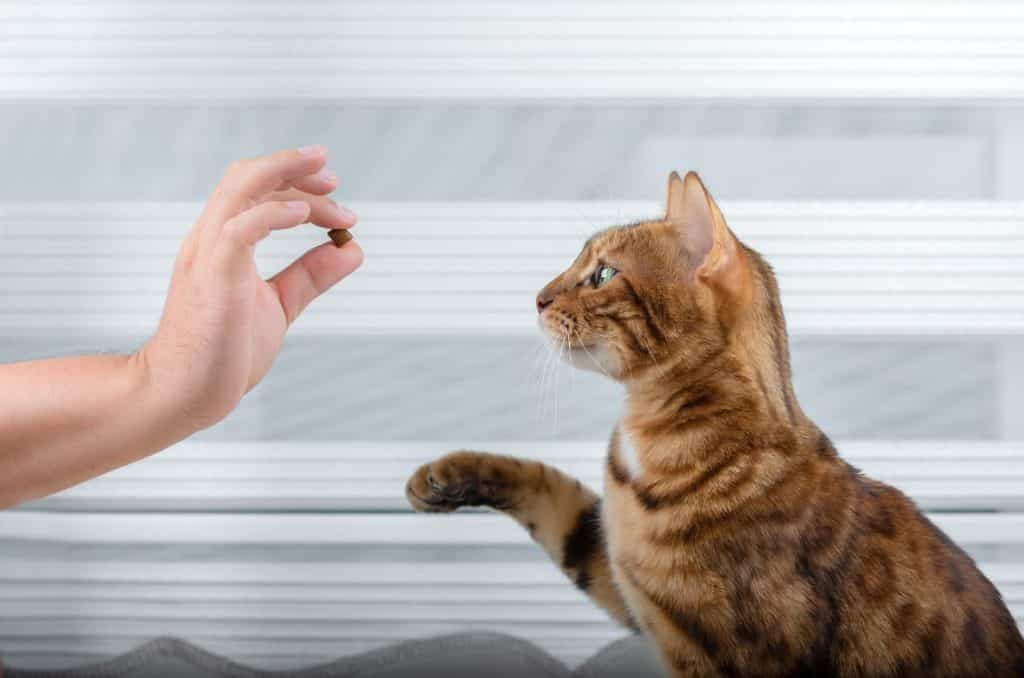Are you a cat owner that is looking to train your feline friend? If so, clicker training might be an option worth exploring. Not only does this type of training help keep your kitty healthy and happy, but it’s also easy enough for even beginners! In this article, we’ll cover what clicker training is and how to use clicker training for cats so you have the tools necessary to get started!

What is clicker training for cats?
Clicker training is a type of “second-order” positive reinforcement training that employs the use of a sound to signal when an animal is performing well. You’ve probably seen a clicker in action if you’ve looked up cat training videos on the internet.
There are many benefits to clicker training for cats! Clicker training uses conditioned reinforcers which means that they will associate the sound of the click with a reward, even if it isn’t food or affection. This saves you time and money as your cat won’t be expecting treats every time they do something good.
Clicker training for cats should begin when the feline is young, usually around three months, but cats can learn at any age. It’s best to begin as soon as your kitten is eating solid foods and can be rewarded.
Successfully training a cat can be a long process. Felines are not always motivated by food as some prefer praise or affection. Clicker training can be the most effective way to train your kitty how to do tricks such as sit, shake hands, jump through hoops of any size, and more! It’s also beneficial for teaching them how to go on walks with their leash.
What you’ll need
- A marker signal such as a clicker, a clicker app, a word like “yes” or even the sound of clapping your hands is good enough.
- Some of your cat’s favorite snacks or foods. Ensure that they’re small pieces so that your kitty can eat fast and keep focused on the task.

How to use clicker training for cats
Your Cat’s First Clicker Experience
Cats’ attention spans are even shorter than dogs’, so limit your training sessions to a few minutes at a time. Your cat will get the hang of it after a few sessions.
- Sit with your cat and have a treat bowl or saucer nearby.
- Toss a treat to your cat as soon as you click the clicker.
- As long as your cat is interested, repeat the technique at random intervals.
- When your cat realizes that each click sound is followed by a reward, he may start looking towards the treats instead of the clicker when he hears the sound.
Using a Clicker for Behavior Training
You’re ready to move on to fundamental actions like sit once your cat appears to comprehend that each click indicates “reward.”
- To begin, ensure that your cat is paying attention to you. Begin by bringing the treat up to the cat’s nose with the clicker in one palm and a delectable treat in the other.
- Slowly slide the treat from his nose to just between his ears once he starts sniffing it. Your cat’s eyes and nows will most likely follow this arc action, and as its chin rises and backs, so will its rear.
- Click and give your cat a treat as soon as his bottom reaches the floor—this is crucial in teaching them the proper behavior.
- Throughout your workout, repeat this exercise numerous times.

Once your cat has mastered using their new skills around the house and is comfortable doing it at any time without needing multiple repetitions, take them out on walks or teach them how to go through an agility course. You can also start teaching more difficult tricks such as playing dead by lying down flat on their back during playtime. Clicker training works well when combined with other methods, so be sure not all trainings rely only upon this technique .
Also, note that when you’re tempting them with a reward, some cats will try to grab it. You could teach these cats to touch a target stick instead. You’ll be able to entice your cat in spot to teach for other actions once he understands that putting his nose to a stick is rewarded.
It’s important when we learn how to use clicker training for cats that we use the marker signal consistently every single time they perform a trick. After a few repetitions, your cat will associate the sound with their reward and this is how how to use clicker training for cats!
Be sure that you are patient and don’t get discouraged if your cat doesn’t catch on right away. Practice makes perfect with how to use clicker training for cats! Soon enough, they will be doing tricks nicely.
Now that you know how to use clicker training for cats successfully, please share this post on Facebook or Twitter so our friends can learn too!







